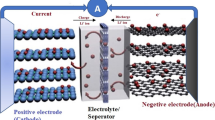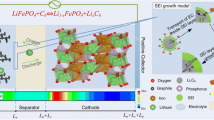Abstract
A numerical model is developed to analyse the effect of hydrogen fluoride (acid) formation on the SEI film (solid electrolyte interphase) on capacity loss in a Li-ion battery under charge–discharge load cycles. Solvent (ethylene carbonate) reaction at the negative electrode/SEI interphase forms Li2CO3 which is the main component of the solid electrolyte interphase. The SEI layer is presumed to dissolve as a result of the formation of the hydrogen fluoride (HF) at the SEI layer and electrolyte interphase. Simulation results indicate that formation and dissolution reaction rate constant of the solid electrolyte interphase directly affect the capacity loss in a Li-ion battery. The potential drop across SEI film is found to be directly related to the rate constants of formation and dissolution reactions. Simulation outcomes are well compared with experimental data.












Similar content being viewed by others
Abbreviations
- \({\phi }_{s}\) :
-
The electric potential at electrode
- \({\phi }_{l}\) :
-
Electrolyte potential
- Δ \({\phi }_{S,film}\) :
-
The potential losses at SEI interphase
- \({c}_{s}\) :
-
Concentration of Li in the electrode particles
- \({c}_{l}\) :
-
Electrolyte salt concentration
- \({\sigma }_{l}\) :
-
Electrolyte conductivity
- f :
-
Activity coefficient of salt
- \({t}_{+}\) :
-
Transport number of Li-ion
- \({i}_{total}\) :
-
Total electro-chemical current sources
- \({Q}_{l}\) , \({Q}_{s}\) :
-
Source term for electrolyte and electrode
- \({\varepsilon }_{l}\) :
-
Electrolyte volume fraction
- \({D}_{l}\) :
-
Electrolyte salt diffusivity
- \({R}_{l}\) :
-
Over-all electrolyte Li-ion source term
- \({i}_{s}\) :
-
Current density in electrode
- i0 :
-
Exchange current density
- σs :
-
Electrical conductivity of electrode
- r p :
-
Particle radius
- θs :
-
Free reaction site
- C s , x :
-
Total concentration of reaction sites
- D s :
-
Salt diffusivity at electrode
- R Li θ :
-
Molar flux of Li in particle surface
- A V :
-
Specific surface area
- R L , c :
-
Additional reaction sources that contribute to total species source
- R Film :
-
Film resistance
- s 0 :
-
Film thickness
- ∆s :
-
Film thickness change
- σfilm :
-
Film conductivity
- η:
-
Activation over potential
- E eq :
-
Equilibrium potential of cell
- Q Cell ,0 :
-
Battery cell capacity
References
Darling R, Newman J (1998) Modeling side reactions in composite Li. J Electrochem Soc 145:991–998
Spotnitz R (2003) Simulation of capacity fade in lithium-ion batteries. J Power Sources 113:72–80. https://doi.org/10.1016/S0378-7753(02)00490-1
Ploehn HJ, Ramadass P, White RE (2004) Solvent diffusion model for aging of lithium-ion battery cells. J Electrochem Soc 151:A456. https://doi.org/10.1149/1.1644601
Kim SP, Duin ACTV, Shenoy VB (2011) Effect of electrolytes on the structure and evolution of the solid electrolyte interphase (SEI) in Li-ion batteries: a molecular dynamics study. J Power Sources 196:8590–8597. https://doi.org/10.1016/j.jpowsour.2011.05.061
Sankarasubramanian S, Krishnamurthy B (2012) A capacity fade model for lithium-ion batteries including diffusion and kinetics. Electrochim Acta 70:248–254. https://doi.org/10.1016/j.electacta.2012.03.063
Wu J, Membreno N, Yu WY, Wiggins-Camacho JD, Flaherty DW, Mullins CB, Stevenson KJ (2012) Influence of hydrofluoric acid formation on lithium ion insertion in nanostructured V 2O 5. J Phys Chem C 116:21208–21215. https://doi.org/10.1021/jp305937b
Laresgoiti I, Käbitz S, Ecker M, Sauer DU (2015) Modeling mechanical degradation in lithium ion batteries during cycling: solid electrolyte interphase fracture. J Power Sources 300:112–122. https://doi.org/10.1016/j.jpowsour.2015.09.033
Deshpande A, Phul S, Krishnamurthy B (2015) A generalized mathematical model to understand the capacity fading in lithium ion batteries-Effects of solvent and lithium transport. J Electrochem Sci Eng 5:181–195. https://doi.org/10.5599/jese.197
Phul S, Deshpande A, Krishnamurthy B (2015) A mathematical model to study the effect of potential drop across the SEI layer on the capacity fading of a lithium ion battery. Electrochim Acta 164:281–287. https://doi.org/10.1016/j.electacta.2015.02.189
Ramesh S, Krishnamurthy B (2015) A mathematical model to study capacity fading in lithium ion batteries: formation and dissolution reactions. J Electrochem Soc 162:A545–A552. https://doi.org/10.1149/2.0221504jes
Choi NS, Han JG, Ha SY, Park I, Back CK (2015) Recent advances in the electrolytes for interfacial stability of high-voltage cathodes in lithium-ion batteries. RSC Adv 5:2732–2748. https://doi.org/10.1039/c4ra11575a
Bi Y, Wang T, Liu M, Du R, Yang W, Liu Z, Peng Z, Liu Y, Wang D, Sun X (2016) Stability of Li2CO3 in cathode of lithium ion battery and its influence on electrochemical performance. RSC Adv 6:19233–19237. https://doi.org/10.1039/c6ra00648e
Wang A, Kadam S, Li H, Shi S, Qi Y (2018) Review on modeling of the anode solid electrolyte interphase (SEI) for lithium-ion batteries. Npj Comput Mater 4. https://doi.org/10.1038/s41524-018-0064-0
Cheng JL, Li XH, Wang ZX, Guo HJ (2017) Mechanism for capacity fading of 18650 cylindrical lithium ion batteries. Trans Nonferrous Met Soc China 27:1602–1607. https://doi.org/10.1016/S1003-6326(17)60182-1 (English Ed)
Singhvi R, Nagpal R, Krishnamurthy B (2016) Modeling the effect of acid attack on the capacity fading in lithium ion batteries. J Electrochem Soc 163:A1214–A1218. https://doi.org/10.1149/2.0601607jes
Xie Y, Lie J, Yuan C (2014) Multiphysics modeling of lithium ion battery capacity fading process with solid-electrolyte interphase growth by elementary reaction kinetics. J Power Sources 248:172–179
Dillon S, Hernandez G, Wagner NP, Svensson AM, Brandell D (2021) Modeling capacity fade in silicon composite electrodes in lithium ion batteries. Electrochimica Acta 377:138067
Ashwin TR, Chung YM, Wang J (2016) Capacity fade modeling of lithium ion battery under cyclic loading conditions. J Power Sources 328:586–598
Dong G, Wei J (2021) A physics-based aging model for lithium-ion battery with coupled chemical/mechanical degradation mechanisms. Electrochimica Acta 395:139133
Carnavole A, Li X (2020) A modeling and experimental study of capacity fade for lithium-ion batteries. Energy and AI: 100032
Zhou F, Bou C (2021) Analysis of the lithium-ion battery capacity degradation behavior with a comprehensive mathematical model. J Power Sources 515:230630
Solchenbach S, Metzger M, Egawa M, Beyer H, Gasteiger HA (2018) Quantification of PF 5 and POF 3 from Side Reactions of LiPF 6 in Li-Ion Batteries. J Electrochem Soc 165:A3022–A3028. https://doi.org/10.1149/2.0481813jes
Liaw BY, Roth EP, Jungst RG, Nagasubramanian G, Case HL, Doughty DH (2003) Correlation of Arrhenius behaviors in power and capacity fades with cell impedance and heat generation in cylindrical lithium-ion cells. J Power Sources 119–121:874–886. https://doi.org/10.1016/S0378-7753(03)00196-4
Acknowledgements
The authors would like to acknowledge BITS Pilani Hyderabad Campus and Council for Scientific and Industrial Research, CSIR Grant No. 22/0784/19/EMRII, which helped us in publishing this article.
Author information
Authors and Affiliations
Corresponding author
Additional information
Publisher's note
Springer Nature remains neutral with regard to jurisdictional claims in published maps and institutional affiliations.
Rights and permissions
About this article
Cite this article
Jha, V., Krishnamurthy, B. Modeling the effect of acid attack on the capacity fading in lithium-ion batteries during cycling. Ionics 28, 2247–2257 (2022). https://doi.org/10.1007/s11581-022-04457-y
Received:
Accepted:
Published:
Issue Date:
DOI: https://doi.org/10.1007/s11581-022-04457-y




